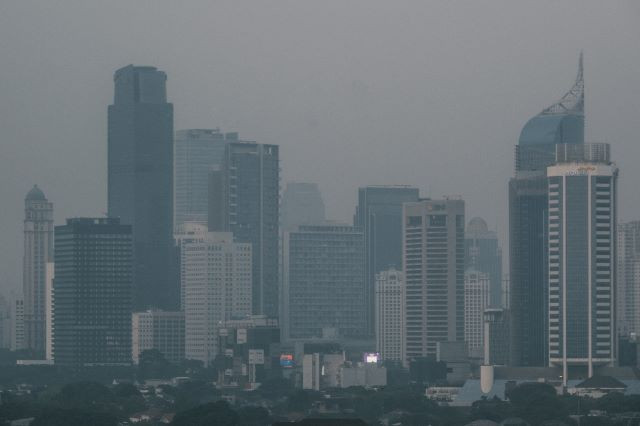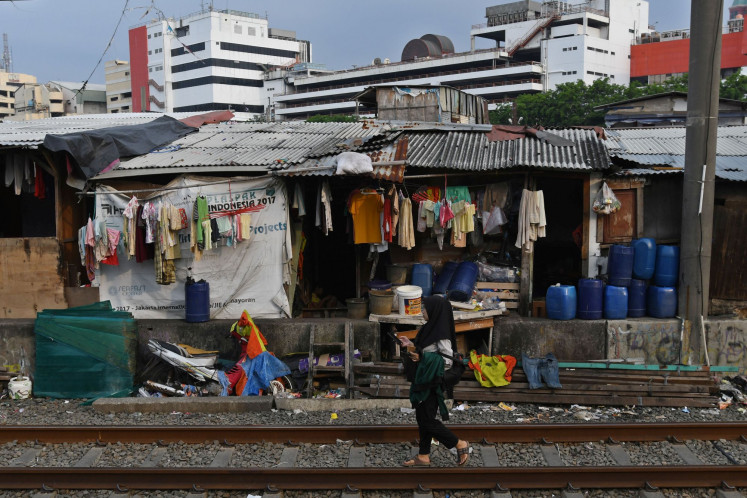Popular Reads
Top Results
Can't find what you're looking for?
View all search resultsPopular Reads
Top Results
Can't find what you're looking for?
View all search resultsUrban play: Jakarta is a big playground
In the eyes of a quirky artistic couple, the chaos and randomness of Jakarta is a huge playground waiting to be explored
Change text size
Gift Premium Articles
to Anyone

I
n the eyes of a quirky artistic couple, the chaos and randomness of Jakarta is a huge playground waiting to be explored. And guess what? They are asking the people of Jakarta to come and play with them.
Duo visual communication artists Irwan Ahmett and Tita Salina have created a game called "Urban Play". To play it, they create art in the form of installation, photography, performance and video using the city's rich elements. The city space becomes their muse, their instrument, and their exhibition ground, all at the same time.
It is a mixture of urban and multimedia art serving as subtle but effective criticism of urban life in Jakarta, based on their experience and observation of the city's minutiae.
From this game/art project, the two have created five artworks so far. Their first one, titled Color Blindness Test, was a result of "playing" in one of Jakarta's traditional wet markets. It is a picture of the word "play", arranged in the fashion of the Ishihara color test using four rattan tray filled with chilies, melinjo fruit, limes and tomatoes.
The innovative and creative spirit of Urban Play is bound to remind us of traditional D-I-Y toy-making - such as creating a toy-car using Pomelo skin - from the days before consumerism dulled our "Macgyver spirit". Urban Play, however, is modern in every sense, starting from the setting: the urban city space; the documentation tools: still-camera and video camera, and the art gallery: the Internet.
The artworks can be seen at dgi-indonesia.com in the online exhibition section. There, one can see their Play*2: Public Furniture installation, a little cave-like seating area, arranged from long wood blocks at a material shop on the side of the street at Jl. Pasar Minggu. In Play*3: Dancing Umbrellas, a short video shows how street vendors created an aesthetic arrangement of umbrellas.
Play*4: Monorail Slalom is a satire on the wasted columns of the defunct monorail project, while Play*5: Jakarate, uses humor to criticize vandalism of public property.
Irwan and Tita make a conscious decision to exhibit their work on the Internet, instead of in a formal art gallery, to underline the people of Jakarta's growing use of the Internet and limited mobility as a result of traffic jams, Irwan said.
"It's possible to see an intersection between the concept of Jakarta and the online *world*. First of all, our mobility is limited as a result of traffic jams. And second of all, the web enables information to spread to a wider audience than through a conventional exhibition," he said.
"It's how viral communication happens in the online world, accommodated by the conventional world," he said recently in a Jakarta caf*.
The two artists at first just wanted to create art by responding to the space in the city. For an example, they wanted to create a new type of font inspired by Jakarta's bus, the metromini. In the end, they realized the city space was not a vacuum and that Jakartans were a dominant part of the city, which made it essential for them to interact with people occupying the space to create their art.
"We cannot just pick random stuff and make it into art. We have to involve people and interact with them," he said.
The challenge, they say, was to create something using only improvisation, innovation, creativity and negotiation. This, Irwan said, could result in visual art or art as a "scale" concept.
The Dancing Umbrella project was an example of a "scale" concept, he said. It showed that street vendors - usually viewed by city officials as a menace to order - were willing to cooperate and able to organize their space into an aesthetic arrangement, using negotiation skills.
"The negotiation process is the interesting part. And that process is what's missing in Jakarta. We found vendors are more artistic than the average artists," he said.
Tita said the response from people asked to participate in their project went far beyond their expectations.
"It was a gamble for us. We were initially pessimistic *about people taking the time to participate in our project*. But people ended up being so kind, they took the trouble to help us," she said.
"We had to present our concept to people who had no idea about *urban* art in two to three minutes. They could then choose to participate," Irwan said.
In Dancing Umbrellas, they had to negotiate with local Pasar Minggu market thugs. When they were shooting the vendors moving the umbrellas around, the thugs ordered them to stop.
"But, they really just wanted us to tell them what we were doing. Once they found out, they let us continue," Irwan said.
From their playing around Jakarta, they said they found a little blessing in each game/project. For their Public Furniture installation, present at the material shop Fajar at Jl. Raya Pasar Minggu from May 7 to 11, they obtained free Wi-Fi connections at the site from the restaurant across the street.
For the Monorail Slalom, they encountered dozens of people doing their Sunday morning jog from Senayan and asked them to run slalom style at the abandoned monorail project.
Irwan and Tita said they would present nine artworks by the end of this month. The next project Irwan said would be about how people living in Jakarta were in a perpetual state of denial.
"People are in denial that they're living in Jakarta. They know that Jakarta is in the tropics, but rather fixing the design *of buildings*, they install lots of air conditioning units," he said.
"Floods are a frequent occurrence in Jakarta; people raise their houses as a result. The streets have a 3-in-1 rule, people then use 3-in-1 jockeys," he said. "I'm just saying, don't deny that you are living in Jakarta," he said.
Whether this project will work out as planned still remains to be seen. They make changes to their project as they go along, they say; such as the Jakarta Monorail Slalom, which they first wanted to do with a car, but decided to do it with passers-by instead.
Iwang said he wanted to stimulate people to see Jakarta in more detail through Urban Play. "Jakarta is rich with detail. A society cannot be called a great society if they neglect detail. If people are used to what's going on and never complain, they won't realize something wrong is going on *in the city*," he said.
"I see Jakarta with enthusiastic eyes. I came to Jakarta with a dream, if Jakarta could not grow with me, the dream couldn't be achieved," he said, adding that he was originally from Ciamis.
Tita meanwhile said that she wanted to ask people to "pay more attention to Jakarta".
"Jakarta has given us so many things, but have we ever stopped to think what we have given to Jakarta? If Jakarta was a person, he/she would feel like the most used person," Irwan said.
Irwan said they wanted to bring Urban Play to other cities in Indonesia and other countries, to watch the different characters of cities coming out.
The couple, who owns the communication visual company Ahmett Salina, funded the art project themselves.
"It's a game for me. A golf trip costs millions, so does an outdoor trip. I spend money for this as a game for myself. This is an outlet for me," Irwan said.
It is also a therapy for Jakarta to feel more intimate, he said. "If this game can reflect a bigger picture, then it's good," he said.
- Photos Courtesy Ahmett Salina









